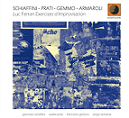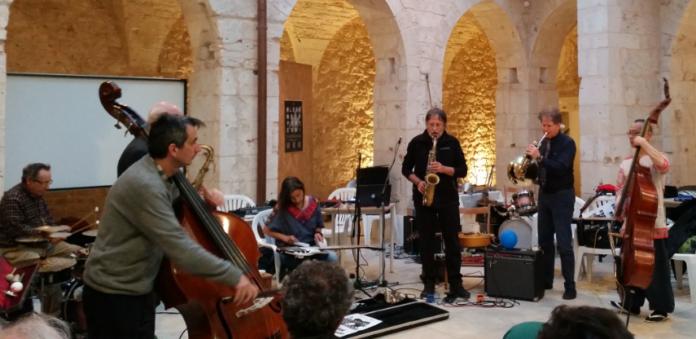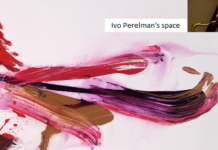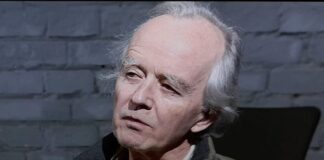 The antinomy between composition and improvisation is often a false one; much contemporary improvised music, even when eschewing any pre-existing formal strictures or explicit structures, shows a predisposition toward a sensibility deeply molded by compositional conventions and strategies. And of course some contemporary improvised music starts from, or is inspired by, a premeditated foundation of a more or less open nature.
The antinomy between composition and improvisation is often a false one; much contemporary improvised music, even when eschewing any pre-existing formal strictures or explicit structures, shows a predisposition toward a sensibility deeply molded by compositional conventions and strategies. And of course some contemporary improvised music starts from, or is inspired by, a premeditated foundation of a more or less open nature.Exercises d’Improvisation, the 1977 suite of relatively short, open-form works by Franco-Italian composer Luc Ferrari (1929-2005), were intended for solo performer or for ensembles of any instrumentation of up to six or eight players. They’ve previously been recorded for solo prepared piano by Ciro Longobardi, in 2011, as well as in 2010 by an electroacoustic quintet that included Ferrari’s widow Brunhild Meyer-Ferrari. Here the seven exercises are realized by the quartet of trombonist Giancarlo Schiaffini, cellist Walter Prati, pianist Francesca Gemmo, and vibraphonist Sergio Armaroli. The foundation for each piece is a pre-recorded electronic backdrop; the performers then choose their own musical materials. As played here, the seven pieces trace a developmental arc that takes them from the low-density, floating and melodically sparse first few exercises through to the more actively played, polyphonically and rhythmically thicker later exercises. Although the sound is, as intended by the composer, a collective one, different instruments or instrumental combinations move into and out of the foreground over the course of the suite. Schiaffini’s trombone and Prati’s cello frequently act as mutual foils, as do Gemmo’s piano and Armaroli’s vibes. The cohesiveness and continuity of the group’s interpretation is made apparent even as individual voices emerge, their contributions as often as not acting as embellishments on the underlying recorded material.
 As with Exercises d’Improvisation, several of the pieces on The Long Line, a duo recording by pianists Massimiliano Coclite and Stefano Travaglini, are improvisations that start with compositional traces or inspirations. Several of the pieces reflect the work or thought of composers Aaron Copland, Paul Hindemith, John Bull and Igor Stravinsky, and there is one arrangement of the standard Body and Soul. The other performances are improvised. The album’s title alludes to a statement of Copland’s that Coclite and Travaglini cite in their liner note, to the effect that the long line “is the be-all and end-all of every composer’s existence.” And the title track does unfurl in long lines, setting rippling chords over a hypnotic pulse and culminating in intricately interwoven, contrapuntal lines laid out on a bed of triplet figures. Folk Songs, Clowns and Litany is based on rhythmic and thematic ideas drawn from Stravinsky’s 1914 trilogy of short pieces for string quartet. Coclite and Travaglini ground their improvisation in Stravinsky’s asynchronous rhythms and compound meters, effectively playing the two pianos off of each other as they do so. The improvisation Ethos, an introspective piece, exemplifies the telepathic interplay that permeates the entire album.
As with Exercises d’Improvisation, several of the pieces on The Long Line, a duo recording by pianists Massimiliano Coclite and Stefano Travaglini, are improvisations that start with compositional traces or inspirations. Several of the pieces reflect the work or thought of composers Aaron Copland, Paul Hindemith, John Bull and Igor Stravinsky, and there is one arrangement of the standard Body and Soul. The other performances are improvised. The album’s title alludes to a statement of Copland’s that Coclite and Travaglini cite in their liner note, to the effect that the long line “is the be-all and end-all of every composer’s existence.” And the title track does unfurl in long lines, setting rippling chords over a hypnotic pulse and culminating in intricately interwoven, contrapuntal lines laid out on a bed of triplet figures. Folk Songs, Clowns and Litany is based on rhythmic and thematic ideas drawn from Stravinsky’s 1914 trilogy of short pieces for string quartet. Coclite and Travaglini ground their improvisation in Stravinsky’s asynchronous rhythms and compound meters, effectively playing the two pianos off of each other as they do so. The improvisation Ethos, an introspective piece, exemplifies the telepathic interplay that permeates the entire album. Gesture’s Consequence, a solo album from Sardinian percussionist Paolo Sanna, is a set of two long studies in extended technique and structure. Sanna has had a longstanding interest in the technical possibilities inherent in percussion instruments of all sorts—standard drumkits, prepared percussion, and various gongs, bells, and non-Western percussion instruments. Although he has a vast array of instruments at his disposal, on Gesture’s Consequence he radically reduces his instrumental footprint to bass drum, wood comb, kalimba box and miscellaneous objects. Of equal importance to Sanna’s musical concept as these sound-producing things is silence, which here plays the role of a secret, inaudible instrument. Like an abstract painter leaving swaths of canvas unpainted or empty of overt color, Sanna deploys silences as a way to break up audible gestures. The effect is both structural and timbral silences work to separate sounding events into semi-independent timbral complexes that, standing exposed, both complement and contrast with each other. The gestural passages themselves are uncluttered and often focused on a single sound texture, the better to coax out its nuances.
Gesture’s Consequence, a solo album from Sardinian percussionist Paolo Sanna, is a set of two long studies in extended technique and structure. Sanna has had a longstanding interest in the technical possibilities inherent in percussion instruments of all sorts—standard drumkits, prepared percussion, and various gongs, bells, and non-Western percussion instruments. Although he has a vast array of instruments at his disposal, on Gesture’s Consequence he radically reduces his instrumental footprint to bass drum, wood comb, kalimba box and miscellaneous objects. Of equal importance to Sanna’s musical concept as these sound-producing things is silence, which here plays the role of a secret, inaudible instrument. Like an abstract painter leaving swaths of canvas unpainted or empty of overt color, Sanna deploys silences as a way to break up audible gestures. The effect is both structural and timbral silences work to separate sounding events into semi-independent timbral complexes that, standing exposed, both complement and contrast with each other. The gestural passages themselves are uncluttered and often focused on a single sound texture, the better to coax out its nuances. Like Sanna, Roman multi-reedist Marco Colonna has devoted much of his career to investigating and broadening the technical resources of his instruments. His Metamorphosis of the Moment, a set of solo performances for metal Bb clarinet and bass clarinet recorded live at St. Martin’s Church during the 2018 Brda Contemporary Music Festival, was issued one month prior to the release in May of this year of The Second Coming. The contrast between these two closely-spaced albums is remarkable, and a testament to Colonna’s versatility and breadth as an artist. Unlike The Second Coming, which contains a series of explorations of extended technique for clarinet and bass clarinet, Metamorphosis of the Moment de-emphasizes extended technique and highlights instead the deeply felt lyricism that is such a vital element of Colonna’s artistry. The compositional aspect here consists in Colonna’s ability to project a long-reaching, well-developed and internally consistent melodic line. In fact, Colonna may well agree with Copland’s assertion about the importance of the long line. Even given the most restricted material, Colonna can build a song imbued with human warmth, as he does on the album’s opening track, Metamorphosis 1. Working with an initial two-note motif, he creates a series of transpositions and variations of phrasing and dynamics that reveal an elaborate world of expression within a constrained pitch set. On Mandilatos, his arrangement of the traditional Thracian dance tune, Colonna harmonizes and counterpoints the basic melody on both clarinet and bass clarinet played simultaneously. His interpretation of Albert Ayler’s composition Children translates the saxophonist’s robust tone, wide vibrato and penchant for the extreme upper register to clarinet; it segues seamlessly into Colonna’s own Metastasi.
Like Sanna, Roman multi-reedist Marco Colonna has devoted much of his career to investigating and broadening the technical resources of his instruments. His Metamorphosis of the Moment, a set of solo performances for metal Bb clarinet and bass clarinet recorded live at St. Martin’s Church during the 2018 Brda Contemporary Music Festival, was issued one month prior to the release in May of this year of The Second Coming. The contrast between these two closely-spaced albums is remarkable, and a testament to Colonna’s versatility and breadth as an artist. Unlike The Second Coming, which contains a series of explorations of extended technique for clarinet and bass clarinet, Metamorphosis of the Moment de-emphasizes extended technique and highlights instead the deeply felt lyricism that is such a vital element of Colonna’s artistry. The compositional aspect here consists in Colonna’s ability to project a long-reaching, well-developed and internally consistent melodic line. In fact, Colonna may well agree with Copland’s assertion about the importance of the long line. Even given the most restricted material, Colonna can build a song imbued with human warmth, as he does on the album’s opening track, Metamorphosis 1. Working with an initial two-note motif, he creates a series of transpositions and variations of phrasing and dynamics that reveal an elaborate world of expression within a constrained pitch set. On Mandilatos, his arrangement of the traditional Thracian dance tune, Colonna harmonizes and counterpoints the basic melody on both clarinet and bass clarinet played simultaneously. His interpretation of Albert Ayler’s composition Children translates the saxophonist’s robust tone, wide vibrato and penchant for the extreme upper register to clarinet; it segues seamlessly into Colonna’s own Metastasi. Sandro Sciarratta, of Agrigento, is a double bassist—unusually, one who plays left-handed—electronics artist, and composer. His solo album Passaggi represents a contemporary take on the composition of musique concrète in the age of digital reproduction. As with any interpretation of works of musique concrète some speculation is involved in identifying sources and the actions taken with them, but most of the eleven pieces on the album appear to be compositions built up out of manipulated recordings of vocal and instrumental music, spoken word and ambient sounds, overlaid with electronic textures. Sometimes this results in abstract soundscapes; by contrast the diptych Sunset and Notturno are beautiful interpretations in simple harmonies of the more tranquil parts of the day, for strings and piano and strings and vibes, respectively. Sciarratta’s bass appears on Passaggio No. 1, where it is accompanied by electronic sounds, as well as on To Barbara Hannigan and Luigi Nono, which appears to be based on a recording of the soprano singing Nono’s Djamila Boupacha. Whatever the provenances or processes involved in its constituent works, Passaggi is an eclectic collection that shows different sides of this multifaceted artist’s work.
Sandro Sciarratta, of Agrigento, is a double bassist—unusually, one who plays left-handed—electronics artist, and composer. His solo album Passaggi represents a contemporary take on the composition of musique concrète in the age of digital reproduction. As with any interpretation of works of musique concrète some speculation is involved in identifying sources and the actions taken with them, but most of the eleven pieces on the album appear to be compositions built up out of manipulated recordings of vocal and instrumental music, spoken word and ambient sounds, overlaid with electronic textures. Sometimes this results in abstract soundscapes; by contrast the diptych Sunset and Notturno are beautiful interpretations in simple harmonies of the more tranquil parts of the day, for strings and piano and strings and vibes, respectively. Sciarratta’s bass appears on Passaggio No. 1, where it is accompanied by electronic sounds, as well as on To Barbara Hannigan and Luigi Nono, which appears to be based on a recording of the soprano singing Nono’s Djamila Boupacha. Whatever the provenances or processes involved in its constituent works, Passaggi is an eclectic collection that shows different sides of this multifaceted artist’s work.






